At first glance, this match seemed to be one of the less interesting ones in the round of the last 32 in the UEFA Europa League. After we saw in this week the first four games of the UEFA Champions League‘s last round of 16, on Thursday evening all remaining 32 teams of the UEL were in action. The game between Alkmaar and LASK Linz was surely not the one which stood out ahead of this round, at least not as much as the Manchester United game for example, but at a closer look, it was quite promising as Alkmaar are in second place in the Eredivisie while LASK Linz are the league leaders in Austria since they bet RB Salzburg last week.
However, the game was especially interesting as Alkmaar played with an unusual starting XI since they currently have several injured players as we’ll see in this analysis. In this tactical analysis, we’ll look at the tactics which Alkmaar and LASK Linz used and explain why the final result was 1-1.
Line-ups
As already mentioned, Alkmaar have currently several injured players and the bad thing is that these are all centre-backs. With Stijn Wuytens, Pantelis Chatzidiakos and Ron Vlaar they missed three centre-backs. Due to that, one of their key players and the captain, Teun Koopmeiners, who is usually a defensive midfielder and important for the build-up, had to play as a centre-back next to Ramon Leeuwin who they bought this January.
The full-backs were the usual ones with Jonas Svensson and Owen Wijndal while Marco Bizot was in goal. The central midfield was made of Jordy Clasie (who joined them at the start of this season from Premier League club Southampton), Hakon Evjen and one of the stars of the team Calvin Stengs. The front three consisted of Dani de Wit, Mayron Boadu and Oussama Idrissi. The head coach Arne Slot usually lets Stengs play as right-winger since then he can dribble to the inside and create something dangerous with his strong left foot, but since Koopmeiners wasn’t available in central midfield, Clasie had to play there and Stengs as an offensive midfielder in 4-1-4-1.
On the other side, Valérien Ismaël went with his usual 3-4-3 formation and changed nothing compared to their victory against RB Salzburg last weekend in the Austrian Bundesliga. Alexander Schlager was in goal while the back three in front of him consisted of Gernot Trauner, Philipp Wiesinger and Petar Filipović. The central midfielders were Peter Michorl and James Holland while the wings got occupied by Reinhold Ranftl and René Renner. The front three were made of the wingers Dominik Frieser and Thomas Goiginger while Marko Raguž was the only centre-forward.
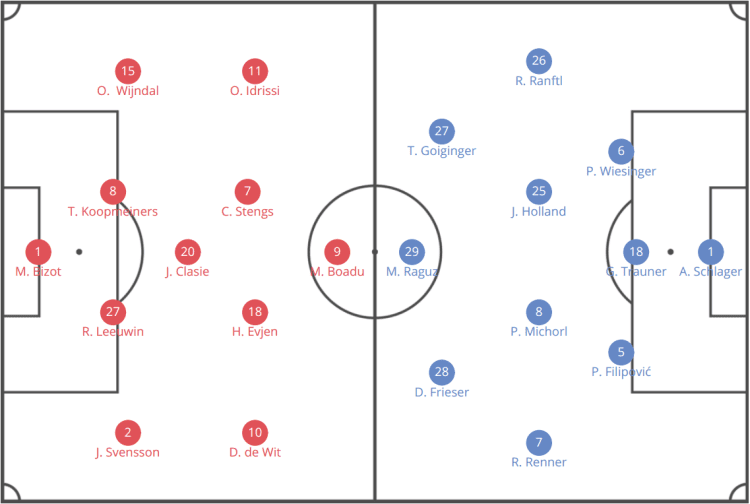
Linz’s basic idea out of possession
In their last game against Salzburg, Linz used an interesting man-orientated approach when their opponents were in possession of the ball. Salzburg used a similar formation (3-4-1-2) and because of that LASK could man-mark every single player of Salzburg during the high pressing without switching their positions. So, they stayed in their 3-4-3, used a high pressing and at the same time man-marked all options for the player on the ball.
Since Alkmaar used a back four and in general, a completely different system, LASK would have had to switch their formation during their press if they wanted to defend in a man-orientated system. Due to that, during their high and intense pressing, which is usual for them, they used a mixture of man-orientated defending and staying in their formation to cut off passing options. We can see their pressing if we look at the graphic below.
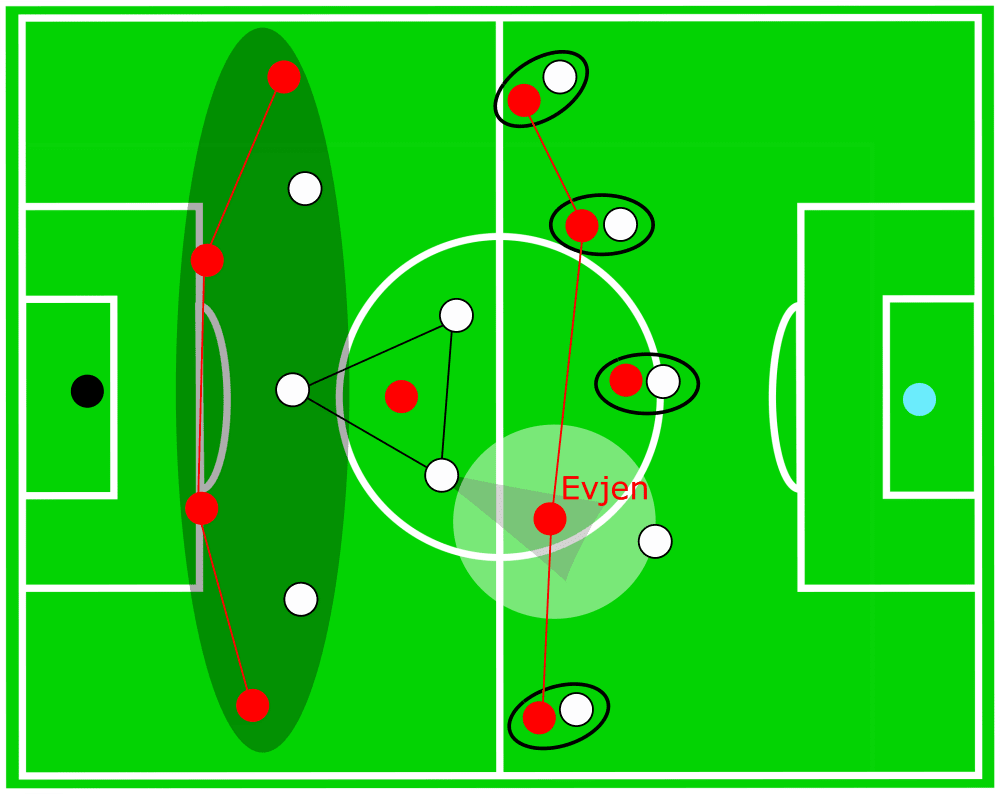
The three forwards Goiginger, Raguž and Frieser put pressure on the back four of Alkmaar at we’ll look at that in a bit more detail later on in this analysis. The central forward as well as the two central midfielders create a triangle around the deepest midfielder Clasie and take him out for most of the time.
They defended in two different ways against the two advanced midfielders Stengs and Evjen. While Evjen mostly moved freely in the space between the midfield and the back three of Linz, Ismaël’s men man-marked Stengs quite often when he positioned himself in the space between the lines. Either Wiesinger stepped out from the back three to mark him or the right wing-back Ranftl shifted in to do so when his usual opponent Idirssi got marked by Wiesinger. So, on LASK’s right side, they man-marked Stengs and Idrissi since they knew that these two would be key players in offence. On the other side, Evjen was almost never marked closely and the central midfielders concentrated on cutting off the passing lines to him, but Alkmaar’s right-winger De Wit got marked by Renner.
Alkmaar’s lack of creativity meets LASK’s press
Of course, it’s not possible that a team executes a high and aggressive pressing for 90 minutes, but you have to give huge credit to LASK as they pressed in at Alkmaar for most of the time. When they put pressure on Alkmaar high up the pitch, they used the defensive approach which I described above in this tactical analysis. Now, we’ll take a closer look at their defensive tactics and explain why Alkmaar hardly found any successful solutions for it.
In the image below, we can see all principles of LASK’s press in the 5-2-3 and 3-4-3 respectively. In this situation, Stengs and Evjen switched sides. Due to that, Stengs is free in the space between the lines, but he’s no real passing option as the central midfielders of LASK cut it off. Meanwhile, the right centre-back of the back three steps out to man-mark Evjen and Ranftl is near Alkmaar’s left-winger Idrissi.
Additionally, Clasie is positioned in the triangle which is created by the two central midfielders and the striker Raguž. The front three is positioned quite narrow in this situation to force the opponents to pass the ball to one of the two full-backs where they then can actively put pressure on them.
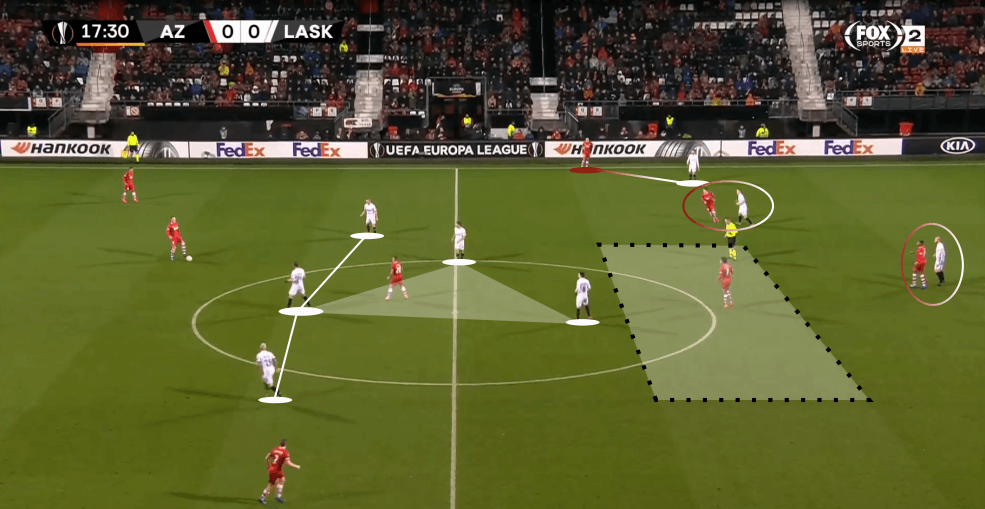
Besides, we saw clearly another idea behind the press of LASK Linz. One of the greatest strengths of Alkmaar is usually their left side with two great talents Wijndal and Idrissi who can be extremely dangerous as a pair on the wing. Also, the left centre-back Koopmeiners is clearly more confident on the ball and better in organising the build-up than his partner Leeuwin. Due to that, when Raguž used his typical curved run to force the opponents to one side, he mainly tried to force them to their right side since there they had the weaker players in the build-up.
As soon as the ball was played to Leeuwin or the right-back Svensson, their actual aggressive pressing started. So, as mentioned above, they stayed horizontally compact while they were positioned really high and provoked the passes to the wing and primarily to the right of Alkmaar. We can see such a typical situation below as all short options are cut off as soon as the ball is played to Leeuwin and he has to play it long.
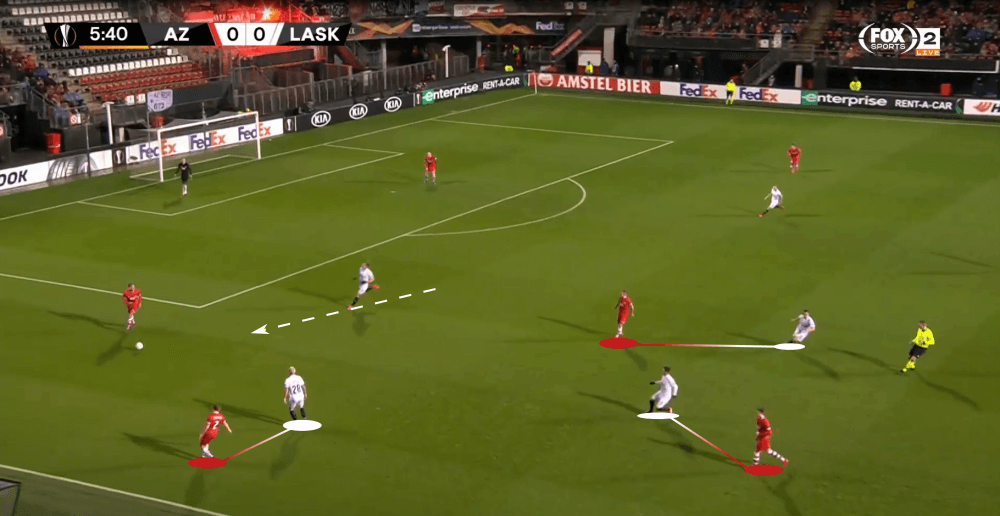
Exactly these long balls were what LASK Linz wanted. The team of Ismaël had the goal to prevent any passes through the centre and also on Alkmaar’s dangerous left side. They wanted to give players like Stengs, Boadu or Idrissi not even the chance to get on the ball and due to that, they tried to force them to opt for long balls and prevent that Slot’s squad could use passing combinations to progress the ball further up the pitch. Besides, LASK’s back three is extremely strong in the air while Alkmaar had no specialists for aerial duels upfront. Due to that, they easily defended these long balls.
The three central midfielders Clasie, Stengs and Evjen showed a poor performance and were almost never successful in searching for free spaces or positioning themselves in them to open up passing lanes. Due to that, Alkmaar’s defenders rarely had any options through the centre and were forced to play the long ball as they had no other option and at the same moment, LASK’s men were putting pressure on them.
In the situation below, we see one of the very few occasions in this game where Slot’s team were able to overcome the press as Koopmeiners provided a passing option to then switch the side as LASK shifted aggressively across during their press.
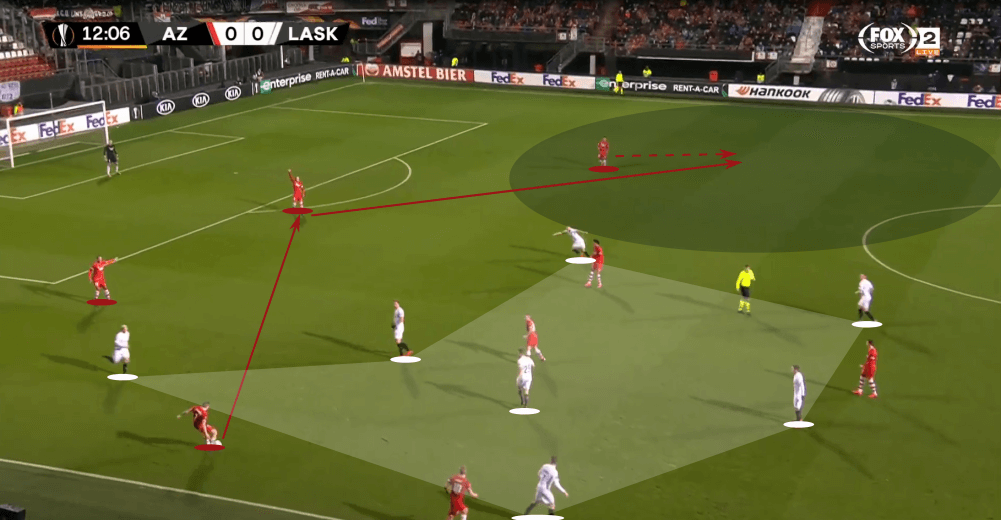
Maybe, if the other centre-backs were fit, Alkmaar used their typical 4-2-3-1 formation and Koopmeiners played in the central midfield, he could have given them more passing options through the centre. However, you clearly noticed that something was missing in the central midfield of Alkmaar.
As already mentioned in this tactical analysis, the central man of LASK Linz’s back three, Trauner, man-marked the talented striker Boadu for the 90 minutes. In the shot below, we can see that Alkmaar’s striker drops deeper to get a second ball, but Trauner follows him and fouls him to avoid a counter-attack. Notice how high up the pitch Trauner follows his opponent.
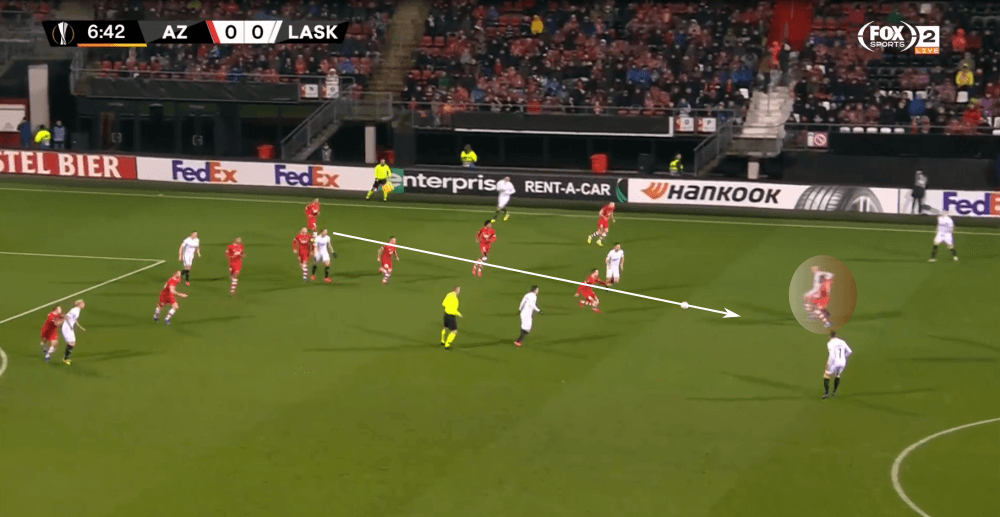
Due to the fact that Linz’s defenders are so much stronger in the air compared to the offensive players of Alkmaar, the Austrians were happy when their opponents played long balls as they defended them easily. To force the opponents to these long passes, LASK positioned themselves high up the pitch ahead of almost every goal-kick (especially in the first half) and marked all short options man to man and forced them once more to a long kick.
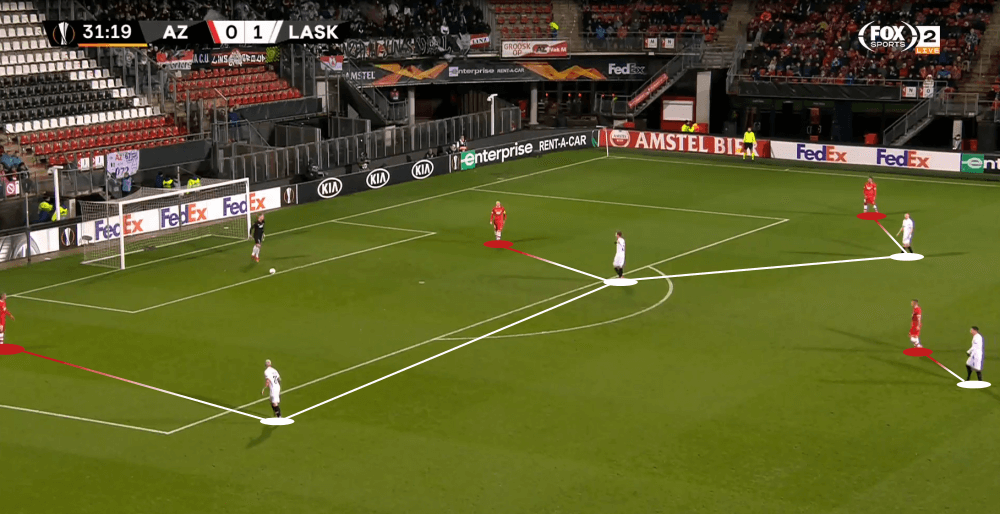
Since it’s not possible to execute the pressing in such an intense way for 90 minutes so high up the pitch, LASK also sometimes sit back deeper in a mid-lock to defend in their 5-2-3 formation. However, the interesting aspect is that you never saw Linz defend extremely deep in their own third. They always put pressure on the opposition at about the height of the half-way line.
Furthermore, LASK Linz are clearly one of the best examples that defending deeper in a low- or mid-block doesn’t necessarily mean that you act passively. Ismaël’s team stays active and puts pressure on the opposition as soon as they enter the half of Linz.
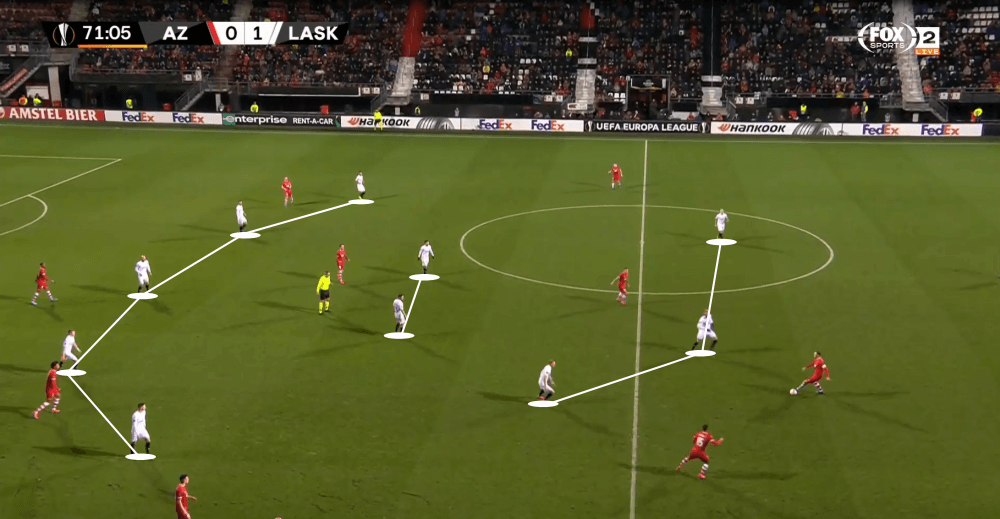
Long balls and counter-pressing
Alkmaar had more possession in this game (61.55%) but still weren’t able to create that many goalscoring chances as they just had four shots on the goal of Schlager (one was a penalty and one was a harmless free-kick). However, also LASK weren’t really able to progress the ball further up the pitch with the combination of short passes. The main reason for that is that Alkmaar also used an effective pressing. They didn’t put pressure on their opposition as high up the pitch as Linz did in this game, but still, they were able to restrict the time their opposition had for a structured build-up.
LASK mostly tried to build-up in their 3-4-3 formation, but as soon as they noticed that they wouldn’t be able to play out from the back with short passes due to the pressing of Alkmaar, they went for the long ball.
The central midfielder Michorl showed in several situations a typical movement for him as he dropped a bit deeper on the left side to position himself next to the left centre-back Filipović. In some games, this helps him to position himself outside of the opposition’s block and receive more passes. However, in this game, the central midfielder Evjen followed him to put pressure on him and also Michorl had no other option than to play the ball long.
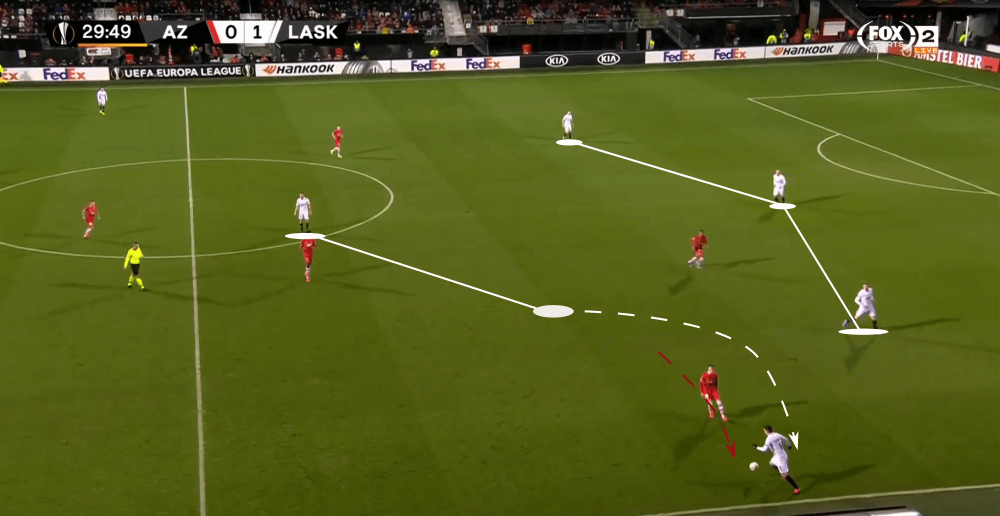
The big difference between Alkmaar and LASK Linz in this aspect is that such long balls are completely typical for Ismaël’s team and they have with Raguž a man in the centre up front who is good in the air and able to lay off the ball for his teammates. Ahead of these long balls, the two wingers Frieser and Goiginger position themselves more narrowly to win the second ball, as we can see in the shot below.
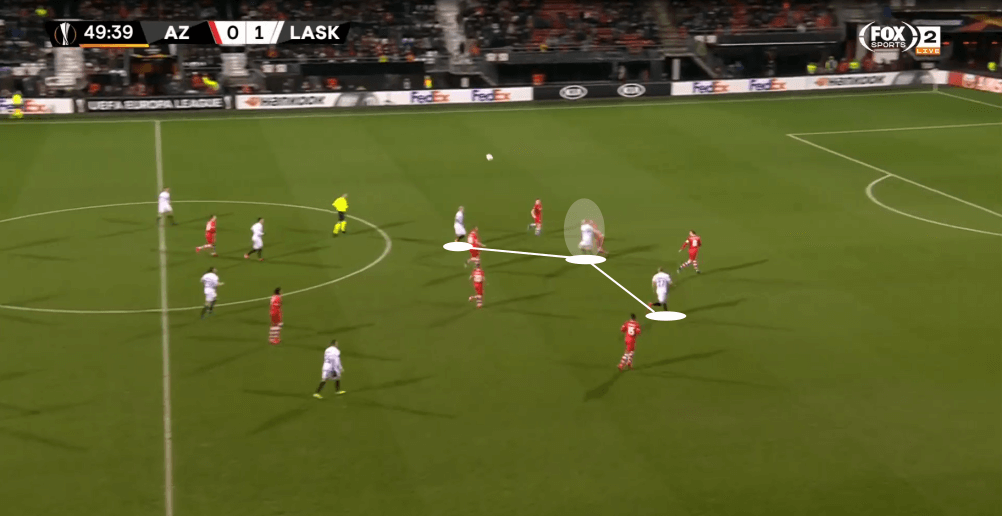
After such long balls in the centre towards Raguž, they wanted to either win the second ball or start the counter-pressing and win it back. They have this plan in almost every match and due to that, it was no huge surprise that they used such long passes. We also saw quite often long balls to the wings as there their counter-pressing works even better since the ball is near the touchline and due to that the opposition have one direction less to play the ball into. In such situations, we can once more see their aggressive and active style of play.
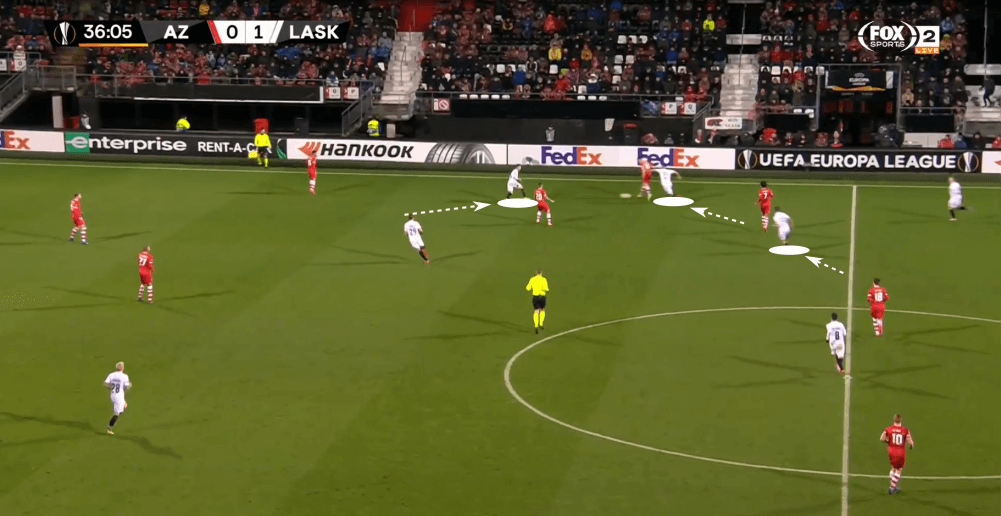
Set-pieces lead to both goals
However, the reason why we don’t look at the creation of goalscoring chances or analyse the movements and tactics of both teams within the final third is because we rarely saw any team creating goalscoring chances. Alkmaar were seldom able to get in the final third as LASK’s pressing worked off that well and additionally the central midfielders showed no good performance. Linz reached the final third more often, but also were not that dangerous. Due to that, it’s no surprise that both goals of the game resulted from set-pieces.
Raguž scored the opening goal of the day after a throw-in. The astonishing aspect about this is that last Friday against Salzburg they scored two goals after throw-ins and still it seemed as Alkmaar weren’t prepared for this. As usual, Trauner went towards the first post to win the aerial duel after Holland’s throw-in and in the centre or at the second post, someone would try to shoot and exactly that worked as Trauner won his duel and Raguž was able to score.
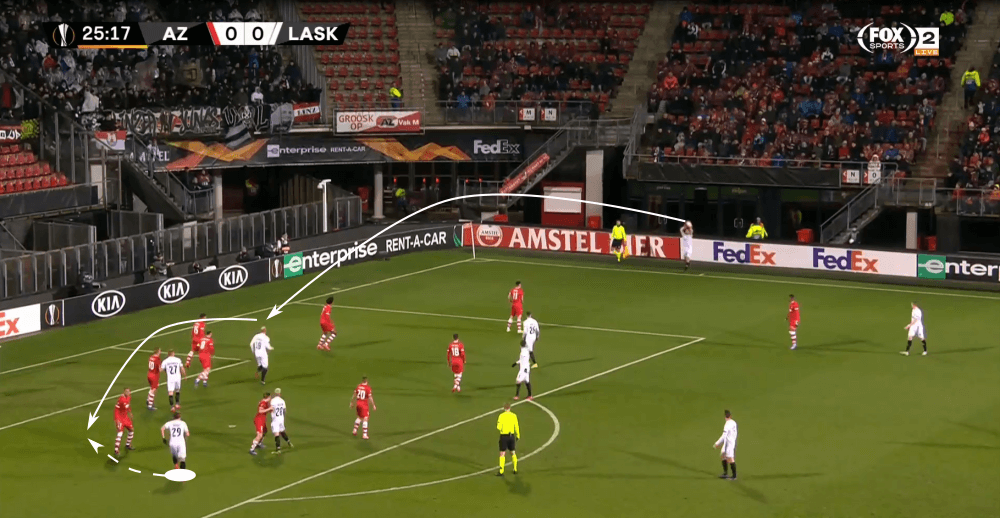
Alkmaar scored the equalizer just a few minutes before the final whistle with a penalty which resulted from a handball after a freekick. Notice in the bottom left corner how Boadu starts his run into the box behind Holland and the ball comes directly towards them. The Australian midfielder of LASK touches the ball with his arm and it leads to the penalty. It’s hard to say if his movement which led to the penalty would have been different if he hadn’t let Boadu start behind him, but it’s safe to say that it wasn’t defended well.
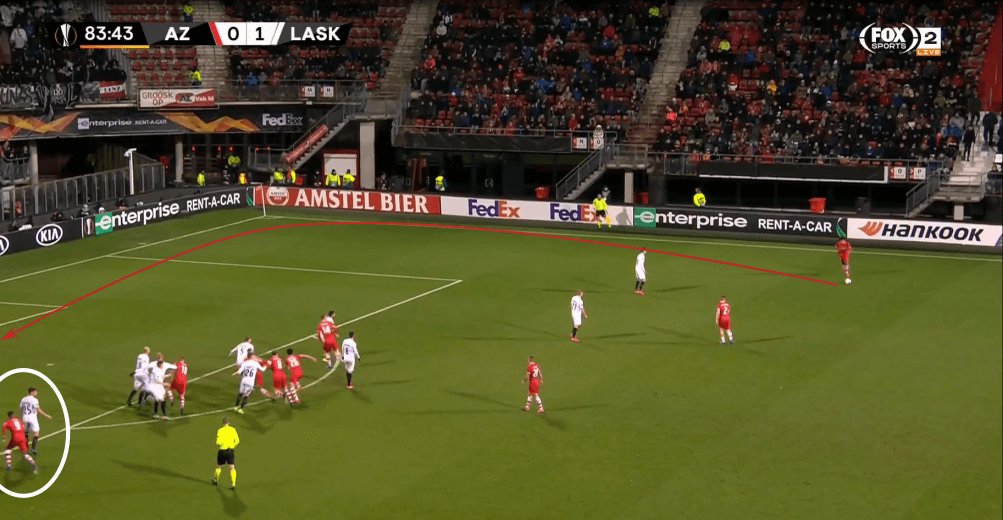
Conclusion
This game was dominated by the good defensive work by both teams while the offensive players on both sides had a really hard game. LASK Linz’s approach during their pressing was quite interesting to watch while you really saw that Stengs doesn’t feel that well in the centre and that they need Koopmeiners in central midfield.
On the other side, after this result, nothing is decided yet. After RB Salzburg’s 4-1 loss away from home against Eintracht Frankfurt, it looks at the moment as LASK could, after next Thursday, be the only Austrian team remaining in the UEFA Europa League.





Comments